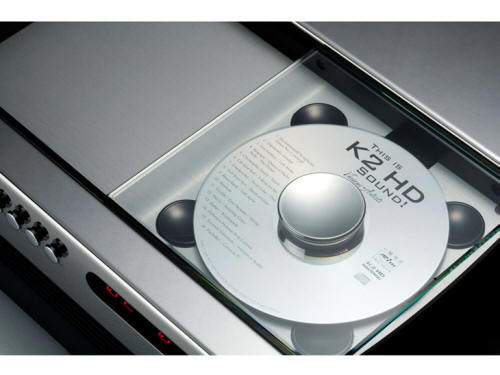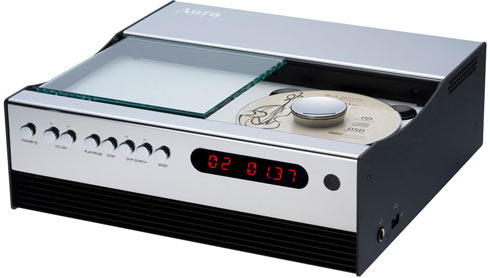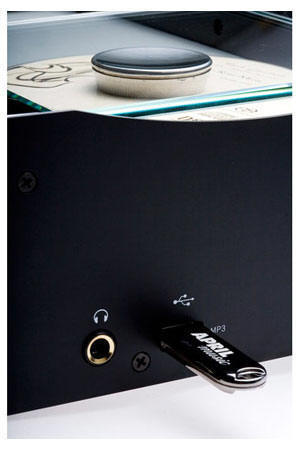|
You are reading the older HTML site Positive Feedback ISSUE 40november/december 2008
The Aura Note All-In-One Music Center
and Audio Epilog Issa loudspeakers ...a paring
for the music loving masses.
I've never been the cool audiophile. Oh, I've heard lots of fantastic sounding systems, hobnobbed with the mob at the super-shows, and heard countless lectures given by industry icons at audio society soirees. Naturally, I've read books and innumerable magazines—foreign and domestic—dedicated to enlightening and expanding the budding enthusiasts. Despite all of these efforts, I still dog paddle in the shallow end. Frankly, when the discussion turns to anechoic measurements and cumulative spectral-plots, I can bluff my way through for a little while. After the first glass of wine, however, the cognoscenti recognize that I'm in over my head, and then it quickly dissolves to the scene in Animal House where I'm meeting fellow losers, making myself at home, and not being shy about helping myself to punch and cookies. Not that being an audiophile dilettante is such a bad thing, somebody has to carry in the boxes, after all, but it does make me wonder why I was chosen to review the Aura Note All-In-One Music Center and Audio Epilog Issa loudspeakers. Granted, to my friends who still dwell in the house of Bose, I'm somewhat of an authority, but anything that can't be wheeled out in a shopping cart is best left to the professionals. Turns out, however, that my downgrade from audiophile to "music lover" (an accurate, if somewhat deflating state of affairs) makes me perfectly suited to measure the success of the Aura Note's claim of a one-box system that produces "huge sound comparable to audio components much larger and far more expensive." The Aura Note follows the now-predictable business model of European-design (in this case, by UK audio guru Kenneth Grange) and Asian manufacturing (here, April Music of South Korea). The loudspeakers in this system demonstrate that Asia is not the only place where cheap labor and resourceful engineering exist in abundance. The Issa loudspeakers (built in Croatia) add to the steady stream of serious audio gear hailing from Eastern Europe. Before giving my opinion of the Aura Note and Audio Epilogs Issa's ability to make music, I should confess that my current system features the sort of classic low to mid-fi range components that the makers of the Aura Note hope to supplant. An Arcam A85 integrated amplifier powers an Arcam T61 tuner and an Arcam (see a theme here?) CD82 compact disc player. Keeping with the Anglophile audiophile angle, I use two pairs of Tannoy Eyris I speakers (one pair each for the front and back room). Through good fortune, I do have high grade interconnects, power cords, and speaker cables, and these have improved, but not transformed, the overall character of the sound heard at home. All of these products have served me well, and have given me countless hours of enjoyment. Repeated music masochism in the form of listening to endless products compels me to admit that none of these products does anything particularly well in any area, but the overall sound is engaging and musical enough for my daily listening. The main point of this is that all of my components have been discontinued and are showing their age, a nice bit of serendipity for those who would entice me to purchase four grand's worth of audio gear ($2350 for the Aura Note, $2500 for the Issa pair). Personally, I find this to be a very attractive price point for a system upgrade. I've yet to receive any large government bail-outs, and I don't see any MBL's in my modest living room in the near future, so the upgrade choice definitely hinges on affordability and practicality, which plays to the strong suit the Aura Note and the Audio Epilogs. Recent one-box products are marketed for those with audiophile aspirations but plebian coin purses. The ubiquitous Arcam Solo continues to dominate the plug-in-play market, but other manufacturers have followed suit, and it's not hard to see why. Setting up the Aura Note required me to open the box, connect the power cord, hook up the speakers, put the glass cover in the groove and slide it over the CD mechanism, and plug in the tuner antenna. Flick the switch and "It's alive!" Ten minutes total set up time (and that's in for God's sake don't break or lose anything mode). As someone who has a rare gift for turning a fifteen-minute connection project into an excruciating half-day affair, the ease of use factor of the Aura Note cannot be undervalued. Of course, in a time where boom boxes disguised as exotic Italian automobiles serve as the arbiter of upscale instant audio, we expect more from a compact system than just being able to go from void to Wagner in less than 60 seconds. Fortunately, the Aura Note includes a variety of essential features: a very serviceable am/fm tuner, a fine CD transport, and an auxiliary out for connecting any stereo device you like (cassette deck, TV receiver, even a turntable, as long as you already own a phono preamp).
In short, the Aura Note provides a convenient, no-hassle package. Before lugging your Telefunken console out of the garage and puffing, "I've already got one!" you might want to experience just how good a little box no bigger than the Sunday newspaper can sound. Although I was hard-pressed to ignore the Siren song of the Issa speakers (more on that in a moment), I first hooked up the Aura Note to my Tannoy standmounts, just to hear the difference between my Arcam separates and the new contender for listening room supremacy. Given the obvious caveat that I've spent years altering speaker placement and cabling to make my current system as pleasing as possible (to my ears, at any rate) I can make some general comparisons between the two. The Aura Note produced a slightly forward presentation, and in Nat King Cole's "Straighten Up and Fly Right" the piano, the upright bass, and the crooner all seemed a little closer to me than it did on the CD 82. At first, I thought I was confusing presentation with increased detail, and I did enjoy the more pronounced presence of the chords voiced by Oscar Moore's semi-hollow body electric guitar, but further listening showed that the Aura Note was less detailed, overall, than the Arcam. The strands of the snare brush used on "If I Were a Bell" from Amel Larrieux's Lovely Standards were more of a piece and less clearly articulated on the Aura Note. Midrange, too, seemed a tad more boxy when the Tannoy's (prone to boxiness even in the best circumstances) were combined with the Aura Note. Just to confirm this suspicion, I played Philip Madoc's narration of Genesis 1-2 from Naxos AudioBooks' The Old Testament. Not your typical selection, I grant you, but I always enjoy the presence of an omniscient deity in my living room (one that I can turn off before the final judgment, anyway) and Madoc does hairy thunderer to a T. Based on the nasally intonation conveyed by the Aura Note/Tannoy pairing, there should have been an eighth day to create a handkerchief. None of this is to say that the Aura Note was unpleasant, in fact, the overall sound produced by the Aura Note was wonderfully engaging. Women's voices, in particular, were conveyed in a very natural, fully dimensional manner. I Don't Know Why by Norah Jones (stop groaning!) sounded fuller and warmer than I was used to hearing. Still, in the back of my mind, I knew that I wasn't being fair to the Aura Note. My speakers are designed to be pleasant, but inoffensive. You can play anything, from Sex Pistols to Sade, and it always produces British wink-and-a-nod affability. Even more to the point, sitting in two fairly large boxes were the Audio Epilogs, with all of their tantalizing promise of room-filling bass and extended midrange. I quickly substituted the pair and eagerly anticipated the results.
Unboxed, carpet spikes screwed in, placement angles measured and secured, I scoured my collection for the appropriate selection. Danny Kaey, the respected reviewer not the multitalented performer, once favored me with a fantastic recommendation for testing (torturing?) woofers. Percussionist Minu Cinelu's collaboration with Sting on "Moun Bandnina" is enough to crumple the cones of even the most steroidal tough-guy speakers, and I was hoping to see how well the Epilogs acquitted themselves in the bottom-end cage match. The disc started spinning, the bass boomed, and the midrange and treble…Well, did I mention that the bass boomed? I figured that I had played unfairly. Undeterred, I entered Sir George Solti into the list and sent him out with "The Ride of the Valkyries." Lots of racket, loads of fun, but not really the explosion of soundstage, dynamics, and coherence I had been expecting.
By
this time, my girlfriend had joined the listening
party, and I was eager to reward her for patiently
enduring a hobby that often produces lengthy debates
on the merits of one meter of wire by serving up a
delicious aural dessert. Her musical tastes differ
radically from mine (e.g. smooth jazz versus a
hobo's stew of dinosaur rock, one-chord blues, and
the detritus amassed from believing every record
review ever penned). In my younger days, we would
have been Siamese fighting fish, locked in a death
struggle for music dominance. Today, I play Sarah Brightman without wincing, content in the knowledge
that, if forced to choose, I'd toss it all on the
fire—gear, tapes, records, CDs, you name it—without
a backwards glance. But that's a tale for another
time, so I cued up Bonnie Raitt's "Love Has No
Pride." Well, disked up to be more accurate, I don't
have a separate phone stage, so records were not an
option. I gave my girlfriend the "get ready for
something special" glance and …well, all right, no
rapture. It was a train wreck. Listen, given my
advancing years and imperfections, I can accept that
look of disappointment in other rooms, but my ego
won't allow it in the listening room! The
incoherence of musical presentation made for a
pitiful sonic failure. The integration of the bass
and the midrange drivers was a disjointed mess. The
speakers moved a lot of air, and our toes enjoyed
the kinesthetic Fortunately, one of the wonderful things about this Aura Note/Audio Epilog system is its relative portability. My listening room is a tiny 10' by 11' deal where you can open the front door and the back window at the same time. Unwilling to give the Epilog's the short shrift; I carefully boxed everything up, and took it to the home of friends. They have a much larger room, and plenty of space to see what the Epilogs can do when given some room to breathe. The tonal improvement due to the change of venue was immediate and significant right from the first selection. The midrange opened up and the bottom end dispersed nicely, giving a very balanced, full sound. Too many times, the discussion of soundstage depth and spatiality is a snipe hunt with people pointing and exclaiming "there's the cellist" and "no, she's over there, behind the man with the cracked oboe." In this instance, the soundstage image was well-defined, especially on acoustic material such as Skip James's "Hard Time Killin' Floor Blues," where both singer and guitar had a palpable presence. Detail and dynamics enjoyed a similar resurgence, and it was easy to distinguish and appreciate the tone and timbre of voices and instruments, such as the banjo, clavinet and tenor sax employed in the Squirrel Nut Zippers frenetic "Ghost of Stephen Foster." It's worth mentioning, however, that it required a pretty good dose of volume for the Aura Note to coax any believable sense of presence from the Issa pair. Clearly, these speakers could gobble up far more power than the Aura Note's fifty watts, although it was only on big orchestral pieces and rambunctious rock (such as my friend's teenage son's curious selection of a Blue Oyster Cult tune) where the speakers seemed underpowered. Given enough volume, this system did just fine on overdriven amps and double-bass drum kits, but headbangers need not apply. The Issa's true calling is in the realm of jazz and classical music where the subtlety and extension of tonal palette lies.
In
fact, my experience with this system indicates that
it tells no lies. For example, it's far less
forgiving of poorly recorded selections than I would
have expected from a one-box approach. Nothing
really sounded bad, if you get my drift, but
nothing was measurably improved, either. MP3 files
sounded the way they always do to me, compressed and
dull, and the Aura Note won't play my Apple Lossless
files, effectively eliminating the majority of my
music files. A definite drawback! Similarly, the
tuner sounds absolutely wonderful when the station's
signal is strong, but static is emphasized when the
One fantastic feature for a radio geek like myself is the ability to record shows on a flash drive that can be inserted in the side USB port. You can record compact discs or anything else connected to the auxiliary out, as well, but it was the ability to record radio that really got me excited. You can also connect a pc and play and record music files through a separate USB port in the back. Finally, a few notes about the overall look and feel of this Aura Note and Audio Epilog Issa system. Aesthetically, the combination is a very clean, modern look that passed the significant other-and-friends test, if that's important to you. The polished chrome and sliding glass panel of the Aura Note gives it pleasing appearance, although it is deceptively heavy. Watch out for those sharp corners! It's fun to slide the glass panel and secure the CD with the magnetic clamp, as well (I always like a bit of toy in my serious machines). The slim, neatly-partitioned look of the Issa speakers features the popular contemporary aesthetic found in so many upscale homes. Available in black or white high gloss lacquer, these speakers really draw attention to their stylish design, and impart a European look that many will find appealing. All in all, the looks and tactile appeal of this system are definite strong points. The final question, of course, is whether or not this system trumps the traditional array of separates. Based on my listening experience, I'd have to say probably not, at least, not if audiophile grade sound quality is the primary concern. But it's close, very close. And if you want the convenience of a compact system with the most essential features on board and at the ready, the Aura Note All-In-One Music Center and Audio Epilog Issa combination delivers in spades. This the first in a series of articles by Dean Seislove about his experiences with various audio components and systems from the non-audiophile, but serious music lover's, point of view. Audio Epilog www.audioepilog.hr April Music www.aprilmusic.com
|





 vibrations, but the bottom end
overwhelmed to the point of distraction. Disc after
disc, it just sounded boomy. I even tried the tuner,
but to no avail. The Wiener Philharmoniker's
performance of Mahler's Symphony No. 5 is usually a
sure-fire aural masterpiece, but not when it is
crammed into a service elevator. It was a "You've
got bassoon in my piccolo!" "Well, you've got
piccolo in my bassoon!" farce. To be fair, when I
sat perfectly within the "sweet spot" and didn't
move a muscle, the music sounded less disjointed,
and on light jazz and acoustic blues sounded quite
delightful. But when I dropped the credit card
remote (a pretty easy task, by the way), the sound
just disintegrated into reverberation. It was
obvious the Issa's were just not a good match for my
room, and the brief glimpse of how good they could
actually sound in the right conditions only added to
my frustration.
vibrations, but the bottom end
overwhelmed to the point of distraction. Disc after
disc, it just sounded boomy. I even tried the tuner,
but to no avail. The Wiener Philharmoniker's
performance of Mahler's Symphony No. 5 is usually a
sure-fire aural masterpiece, but not when it is
crammed into a service elevator. It was a "You've
got bassoon in my piccolo!" "Well, you've got
piccolo in my bassoon!" farce. To be fair, when I
sat perfectly within the "sweet spot" and didn't
move a muscle, the music sounded less disjointed,
and on light jazz and acoustic blues sounded quite
delightful. But when I dropped the credit card
remote (a pretty easy task, by the way), the sound
just disintegrated into reverberation. It was
obvious the Issa's were just not a good match for my
room, and the brief glimpse of how good they could
actually sound in the right conditions only added to
my frustration. signal's weak. I have a rooftop antenna that boosts
the signal from pathetic to feeble, so I had to
resign myself to this feast or famine arrangement. I
have to admit, that listening to my favorite
Saturday morning opera show broadcast with a strong
signal was a sublime experience.
signal's weak. I have a rooftop antenna that boosts
the signal from pathetic to feeble, so I had to
resign myself to this feast or famine arrangement. I
have to admit, that listening to my favorite
Saturday morning opera show broadcast with a strong
signal was a sublime experience.